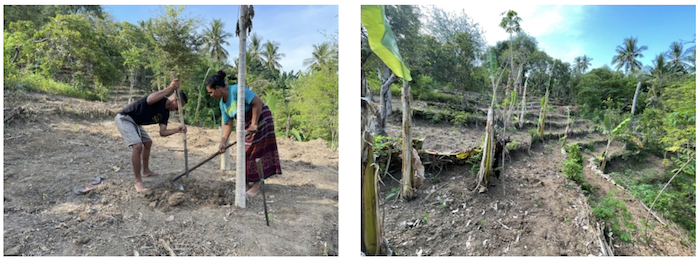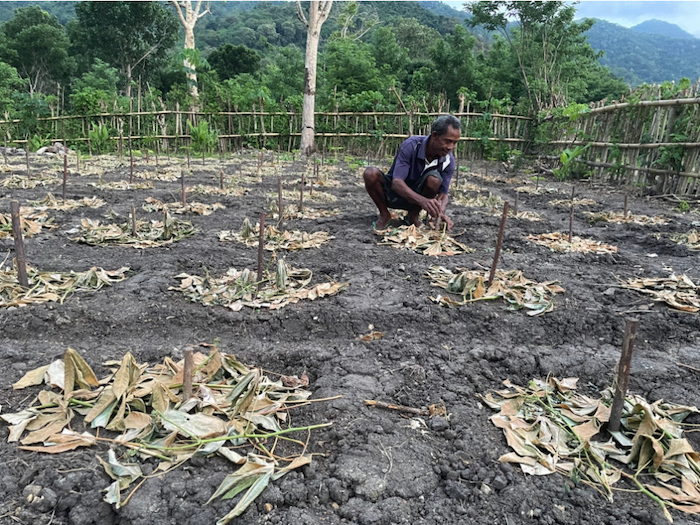
Krensensiana Nasa and her son work on their terraced land, which is generating 3.5 times more income as a result of conservation agriculture techniques. Photo by Miklos Gaspar
Scaling Up
Local agriculture authorities have taken notice, too. As of 2023, conservation agriculture was promoted in a handful of villages by FAO through a local implementing partner, the Foundation for Partnership with Independent Farmers. The District Agriculture Office has now made this technique accessible to all farmers cultivating marginal lands in the area.“These are very impressive results, and we have decided to roll out the methodology throughout the district through extension workers,” says Oliva Monika, Head of the Ministry of Agriculture’s Nagekeo District Office.The Nagekeo district has around 21,000 farmers, and around 10% of them work on marginal lands. These are cases where the land is either too steep, like in Nangaroro, with rainfall gushing down on natural slopes causing the loss of the top-most, fertile soil, or the land is completely flat, with rainwater having nowhere to flow – turning what could be rich agricultural fields into wetlands.The latter has been the case for Amandus Buiu, a small-scale farmer in Wolowae, who could only plant rice rather than corn or horticultural products, which fetch a higher price, because his one-acre plot often gets flooded.Amandus’ flat plot now has small drainage canals to guide excess rainwater that the soil cannot absorb down to the nearby creek. With these techniques, Amandus has been able to diversify his planting. Intercropping of corn with beans has also meant that there is enough shade, moisture and natural fertilizer from leaves in the soil for both plants to thrive. In the meantime, he has kept a rice paddy at the end of his plot, closest to the creek. “I am still experimenting with what balance of crops will work the best,” he says.
Intercropping of corn and beans and developing small drainage canals have enabled Amandus Buiu to turn what was formerly flooded land into a productive farm. Photo by Miklos Gaspar
Supporting Farmers, Sustaining the Environment
The support was much needed in Nagekeo, part of the East Nusa Tenggara Province, one of the five least developed areas of Indonesia. Most of these provinces are agricultural, and moving farmers out of subsistence agriculture into generating an income is a key goal of the government, said Wayan Tambun, FAO Project Manager in Indonesia.“The methods we, and our local partners, are helping the farmers implement will assist in conserving the land and resources, while increasing yields and incomes,” he says.In another marginal area, Rendubutowe, where high elevation means much lower rainfall, FAO partners, World Neighbors and Vredeseilanden Country Office Indonesia, have introduced to farmers the idea not only of terracing and the use of hedgerows to conserve soil and water but also of planting trees in order to minimize water run-offs in the rainy season and limit water shortages in the dry season. Farmers have moved from slash and burn agriculture and shifting cultivation to permanent farming. As a result of the new practices, the land in many areas is now covered by forests, providing natural erosion and flood control, carbon storage and giving rise to new water springs.“Before, our land was barren and infertile and could be used for agriculture only five to seven months per year,” says farmer Antontius Pati.Twenty-five years later, his farm now consists of terraced land and areas with mahogany and gmelina trees, whose seeds and firewood he can also sell.“Before, I had to move the farm to a new piece of land because once there had been three harvests, the soil was no longer fertile,” he says. “But with terracing and the use of leaves from leguminous crops as green fertilizer, my harvest kept on increasing.”His “family forest”, as he calls it, ensures that the local creek never dries out and there is water in the soil year-round.Inheriting marginal land is no longer a curse, Seferinus says. Now he can even think of taking a trip outside the province.“With our older children now in Jakarta, we hope we can go and visit them,” he says.Conservation agriculture techniques enable smallholders to adopt more efficient practices, which can reduce crop losses and offer higher returns. FAO is working with the Indonesian government to expand the use of this technique nationwide.The No-Till Passport series is brought to you by Martin Industries.
Since 1991, Martin Industries has designed, manufactured and sold leading agriculture equipment across the U.S. and Canada. Known for Martin-Till planter attachments, the company has expanded to include a five-step planting system, closing wheel systems, twisted drag chains, fertilizer openers and more in their lineup. Their durable and reliable planter attachments are making it possible for more and more farmers to plant into higher levels of residue.
Related Content:
No-Tiller Shares Challenges of Farming in Ukraine During Wartime
Organic No-Till Helps Ukrainian Farmer Manage Minimal Moisture







Post a comment
Report Abusive Comment